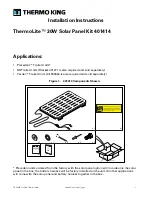
TK 56579-11-IS-EN (Rev. A, 10/20)
©2020 Trane Technologies
13
Solar Panel Troubleshooting Guide
Use the following table to troubleshoot ThermoLite Solar Panel Systems.
STEP
ACTION
RESULT
COMMENT
1
Verify the system is connected to a battery.
The system will not operate
if not connected to a
battery.
2
Verify the battery voltage is between 11V & 12.6V
Either discharge or charge the
battery to the range for the
solar charge controller to
operate
The solar controller will
only operate if the battery
voltage is within the range
of 11V to 12.6V.
3
Verify system operation by exposing the panel to sufficient
light.
Any amount of sunlight (even
cloudy day) will result in some
current (>100mA) flowing to
the battery. This must be
verified with an amp clamp
around the positive cable to the
battery.
If tested inside, at least
500W of halogen light at a
range of about 12-24"
should be used. Ensure the
light shines on the entire
panel.
4
Check if the fuse is present in the harness and verify
continuity
Ensure any replaced fuse is
rated at 20A.
5
Is the solar charge controller present in the system (applies to
36 & 100W systems)?
Once connected, the charge
controller will take up to 1
minute to turn on and start
charging. At this point current
will be flowing.
The absence of a charge
controller will result in
unregulated power input to
the battery that could
under or overcharge the
battery.
6
Verify cable polarity using the diagrams provided in the
installation instructions TK 56127 and TK 56237 (applies to 36
& 100W systems).
Cable Polarity is swapped in the
controller so the polarity from
start to finish must be checked.
If polarity is found to be wrong,
swap the pins in the extension
cable.
This is a common issue
during installation if the
connector is installed
backwards and the polarity
isn't checked.
7
Confirm cable integrity
Check cable integrity to ensure
that abrasions, scrapes, or
breaks in the wire are not
affective voltage drop or power
loss.
Breaks in the power cable
anywhere along the line
will result in voltage or
power loss that will result in
ineffective charging.
8
Verify solar panel output (without charge controller) by
disconnecting the panel from the harness and checking
voltage output at the panel plug connector.
Unregulated panel output
voltage may range from
approximately 17V to 21V. If
the panel has low output
voltage then it's defective and
should be replaced.
Testing the panel output
will isolate the issue in the
system.
9
Confirm charge controller functionality.
With the panel in sunlight the
system should put out at least
200mAmps.
If all above tests are
confirmed then use an Amp
clamp with at least 3
decimal points around the
positive cable going to the
battery.

































